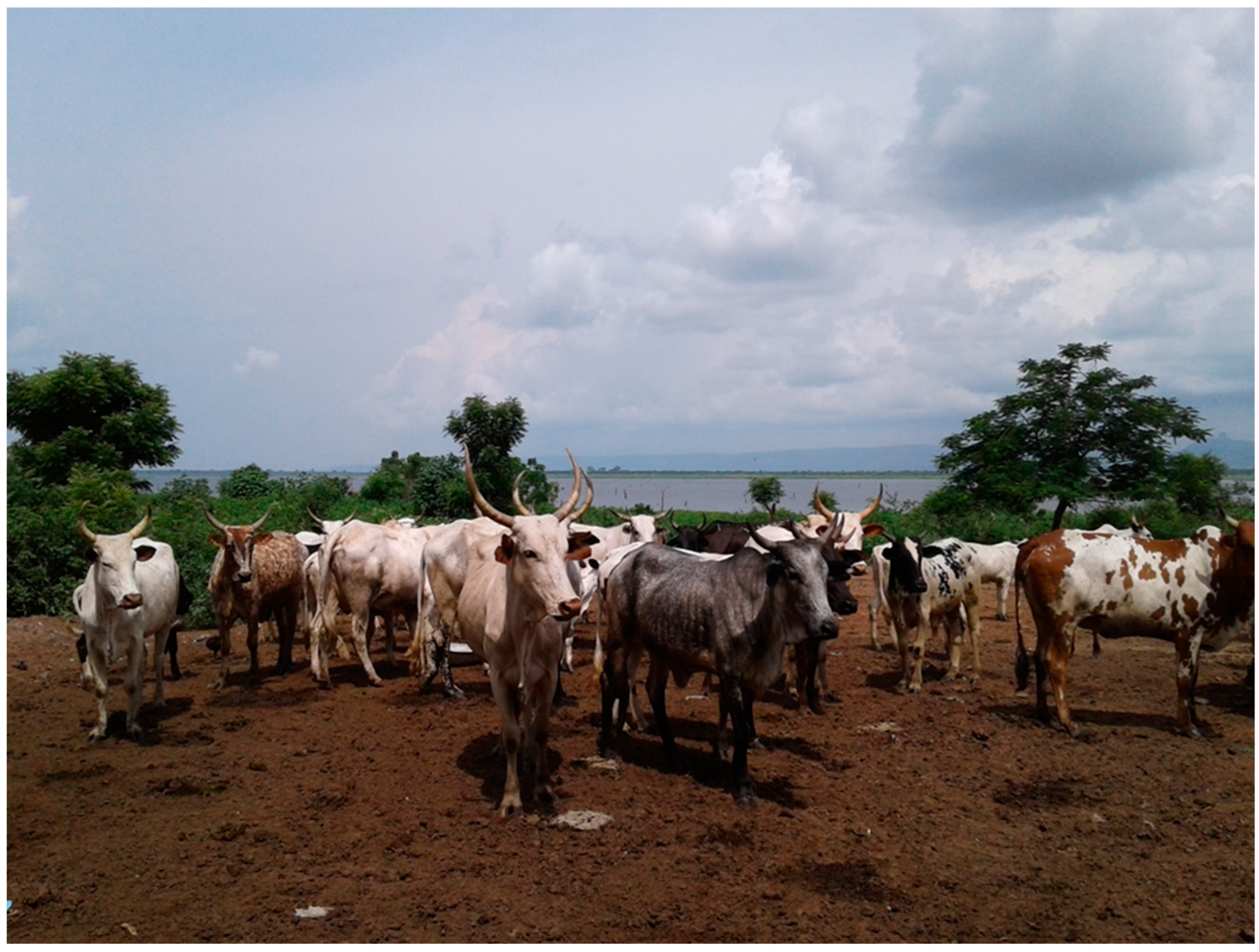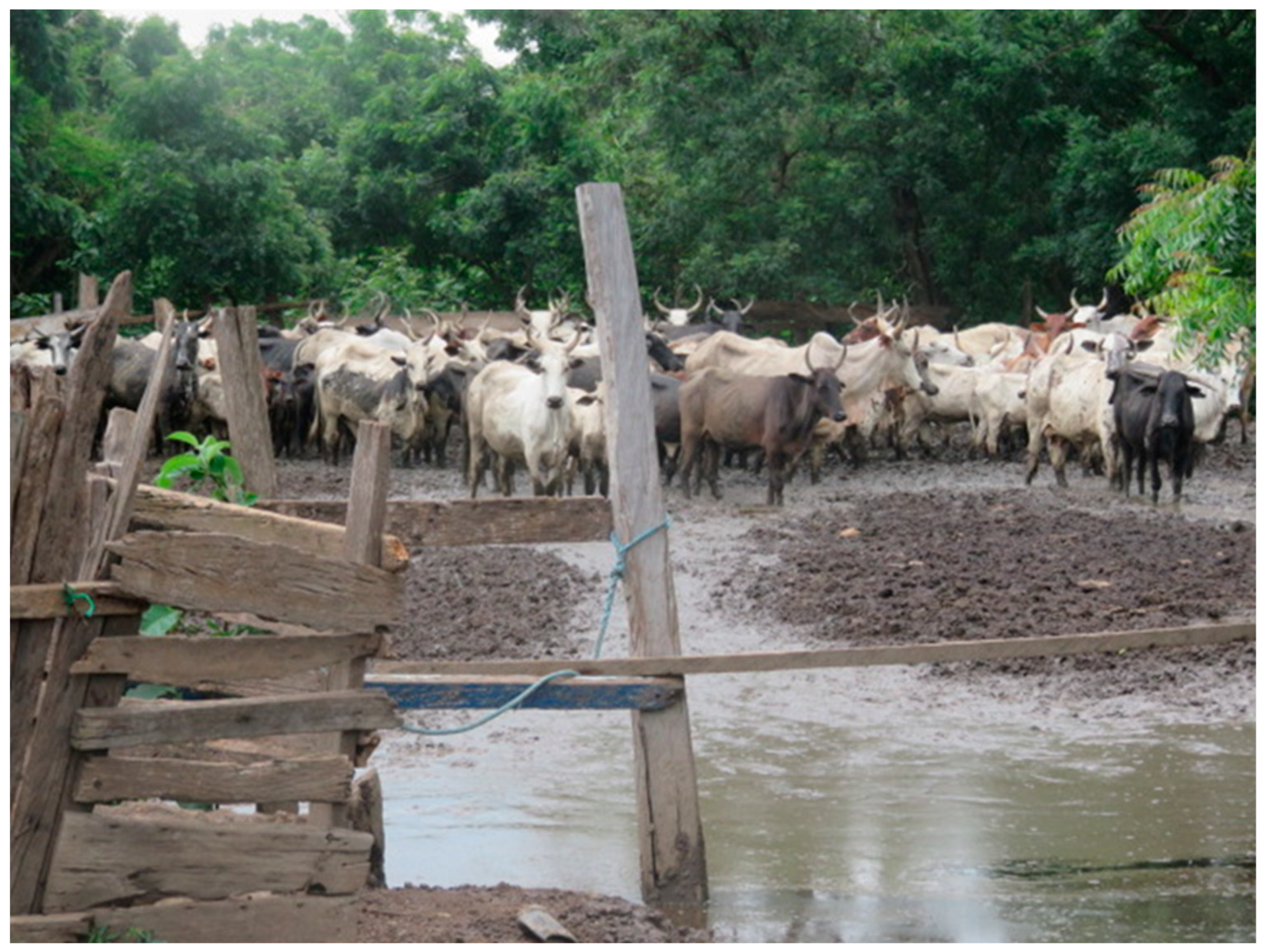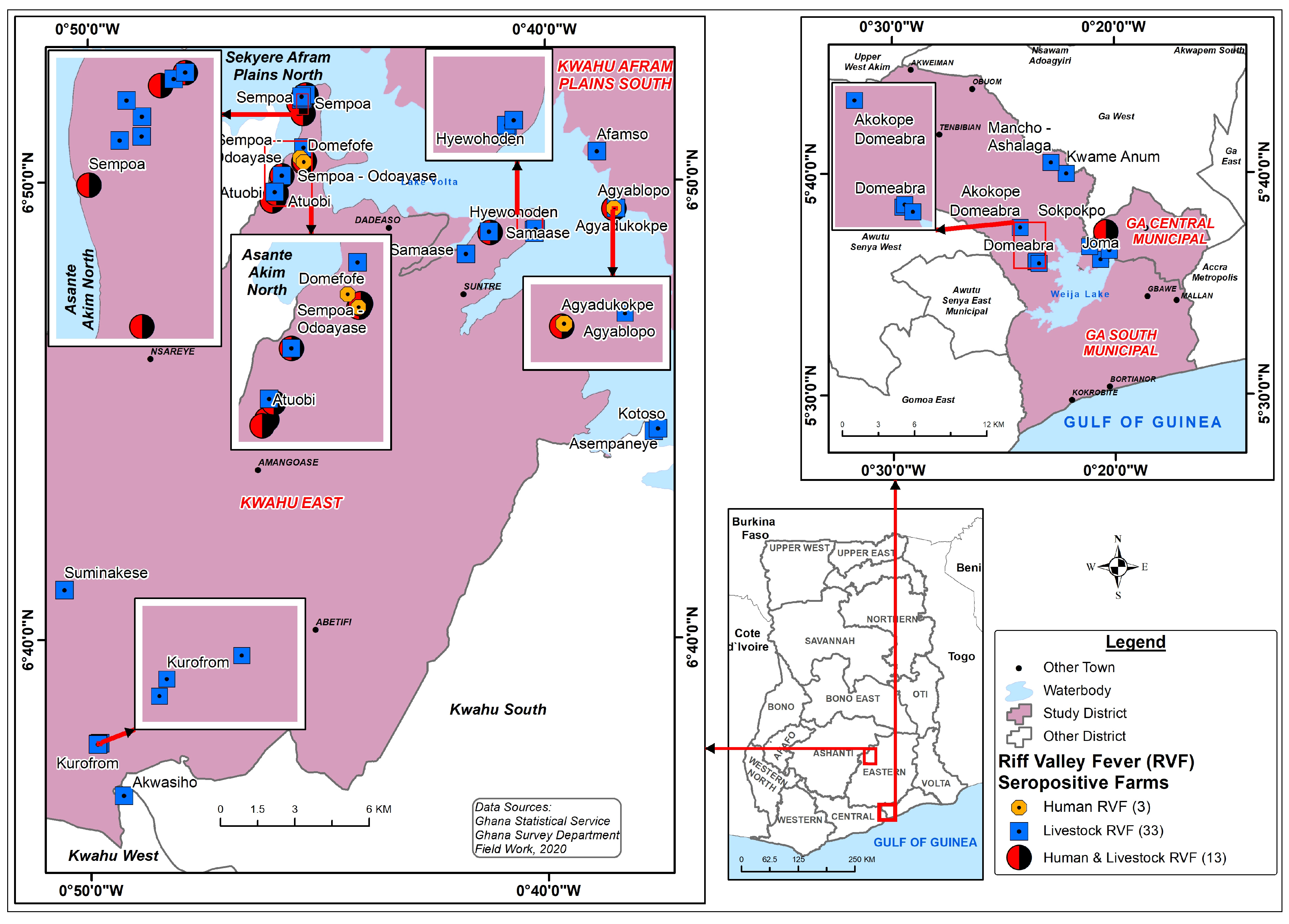Evidence of Rift Valley Fever Virus Circulation in Livestock and Herders in Southern Ghana
Abstract
1. Introduction
2. Materials and Methods
2.1. Study Area
2.2. Target Population and Sample Size
2.3. Sampling-Farms and Livestock
2.4. Variables Measured
2.5. Blood Sampling and Laboratory Analyses
2.6. Human Serosurvey
2.7. Data Analysis
2.8. Ethics Clearance
3. Results
3.1. Farm Characteristics
3.2. Breeds and Flock Sizes
3.3. Seroprevalence in Ruminants
3.4. District and Farm-Specific Prevalence of RVFV
3.5. Seroprevalence in Ruminant Herders
4. Discussion
5. Conclusions
Author Contributions
Funding
Institutional Review Board Statement
Informed Consent Statement
Data Availability Statement
Acknowledgments
Conflicts of Interest
References
- Berger, S. Rift Valley Fever (2018th ed.). GIDEON Informatics. 2018. Available online: https://public.ebookcentral.proquest.com/choice/publicfullrecord.aspx?p=5296042 (accessed on 20 November 2019).
- WHO RVF Facts Sheet. 2018. Available online: https://www.who.int/news-room/fact-sheets/detail/rift-valley-fever (accessed on 20 December 2022).
- Pepin, M.; Bouloy, M.; Bird, B.; Kemp, A.; Paweska, J. Rift Valley fever virus (Bunyaviridae: Phlebovirus): An update on pathogenesis, molecular epidemiology, vectors, diagnostics and prevention. Vet. Res. 2010, 41, 61. [Google Scholar] [CrossRef]
- Venter, M. Assessing the zoonotic potential of arboviruses of African origin. Curr. Opin. Virol. 2018, 28, 74–84. [Google Scholar] [CrossRef]
- Nanyingi, M.O.; Muchemi, G.M.; Thumbi, S.M.; Ade, F.; Onyango, C.O.; Kiama, S.G.; Bett, B. Seroepidemiological survey of rift valley fever virus in ruminants in garissa, kenya. Vector Borne Zoonotic Dis. 2017, 17, 141–146. [Google Scholar] [CrossRef]
- World Health Organization Regional Office for Africa (WHO/Africa). Niamey: Revue Après Action Contre L’épidémie de la Fièvre de la Vallée de Rift au Niger. [Niamey: Review after Action against the Rift Valley Fever Epidemic in Niger]; WHO: Brazzaville, Africa, 2017; Available online: http://www.afro.who.int/fr/news/niamey-revue-apres-action-contre-lepidemie-de-la-fievre-de-la-vallee-de-rift-au-niger (accessed on 4 October 2021).
- Lorenzo, G.; López-Gil, L.; Warimwe, G.M.; Brun, A. Understanding Rift Valley fever: Contributions of animal models to disease characterization and control. Mol. Immunol. 2015, 66, 78–88. [Google Scholar] [CrossRef]
- Msimang, V.; Thompson, P.N.; Jansen van Vuren, P.; Tempia, S.; Cordel, C.; Kgaladi, J.; Khosa, J.; Burt, F.J.; Liang, J.; Rostal, M.K.; et al. Rift Valley Fever Virus Exposure amongst Farmers, Farm Workers, and Veterinary Professionals in Central South Africa. Viruses 2019, 11, 140. [Google Scholar] [CrossRef]
- Bird, B.H.; Ksiazek, T.G.; Nichol, S.T.; Maclachlan, N.J. Rift Valley fever virus. J. Am. Vet. Med. Assoc. 2009, 234, 883–893. [Google Scholar] [CrossRef] [PubMed]
- Lichoti, J.K.; Kihara, A.; Oriko, A.A.; Okutoyi, L.A.; Wauna, J.O.; Tchouassi, D.P.; Tigoi, C.C.; Kemp, S.; Sang, R.; Mbabu, R.M. Detection of Rift Valley Fever virus interepidemic activity in some hotspot areas of kenya by sentinel animal surveillance, 2009–2012. Vet. Med. Int. 2014, 2014, 379010. [Google Scholar] [CrossRef] [PubMed]
- Alhaji, N.M.; Babalobi, O.O.; Isola, T.O. A quantitative exploration of nomadic pastoralists’ knowledge and practices towards Rift Valley fever in Niger State, North-central Nigeria: The associated socio-cultural drivers. One Health 2018, 6, 16–22. [Google Scholar] [CrossRef]
- WHO Regional Office for Africa. Niger: Rift Valley Fever (Situation as of 05 October 2016). Available online: http://www.afro.who.int/en/clusters-a-programmes/dpc/epidemic-a-pandemic-alert-and-response/outbreak-news/5079-niger-riftvalley-fever-situation-as-of-05-october-2 (accessed on 25 January 2019).
- Rissmann, M.; Eiden, M.; Wade, A.; Poueme, R.; Abdoulkadiri, S.; Unger, H.; Ziegler, U.; Homeier, T.M.H.; Groschup, M.H. Evidence for enzootic circulation of Rift Valley fever virus among livestock in Cameroon. Acta Trop. 2017, 172, 7–13. [Google Scholar] [CrossRef] [PubMed]
- Kanouté, Y.B.; Gragnon, B.G.; Schindler, C.; Bonfon, B.; Schelling, E. Epidemiology of brucellosis, Q fever and Rift Valley Fever at the human human and livestock interface in the Northen Cote d’Ivoire. Acta Trop. 2017, 165, 66–75. [Google Scholar] [CrossRef] [PubMed]
- Gonzalez, J.P.; Le Guenno, B.; Some, M.J.R.; Akakpo, J.A. Serological evidence in sheep suggesting phlebovirus circulation in a Rift Valley fever enzootic area in Burkina Faso. Trans. R. Soc. 1992, 86, 680–682. [Google Scholar] [CrossRef]
- Boussini, H.; Lamien, C.E.; Nacoulma, O.G.; Kaboré, A.; Poda, G.; Viljoen, G. Prevalence of Rift Valley fever in domestic ruminants in the central and northern regions of Burkina Faso. Rev. Sci. Tech. 2014, 33, 893–901. [Google Scholar] [CrossRef] [PubMed]
- Amoako, C.; Boamah, E.F. The three-dimensional causes of flooding in Accra, Ghana. Int. J. Urban Sustain. Dev. 2014, 7, 109–129. [Google Scholar] [CrossRef]
- Nkrumah, F.; Klutse, A.M.; Adukpo, D.C.; Owusu, K.; Quagraine, K.A.; Owusu, A.; Gutowski, W., Jr. Rainfall Variability over Ghana: Model versus Rain Gauge Observation. Int. J. Earth Sci. 2014, 5, 673–683. [Google Scholar] [CrossRef]
- NADMO. 2018. Available online: http://nadmo.gov.gh (accessed on 8 January 2019).
- VSD Annual Report 2017; Veterinary Services Directorate: Accra, Ghana, 2017.
- Government of Ghana, Ministry of Health, National Surveillance Unit. Technical Guidelines for Integrated Disease Surveillance and Response in Ghana; Government of Ghana, Ministry of Health, National Surveillance Unit: Accra, Ghana, 2002.
- European Centre for Disease Prevention and Control. Rift Valley fever. In Annual Epidemiological Report for 2016; ECDC: Stockholm, Sweden, 2018; Available online: https://www.ecdc.europa.eu/en/publications-data/rift-valley-fever-annual-epidemiological-report-2016 (accessed on 5 May 2023).
- Awuni, J.; Odoyye, J. Laboratory Results. Accra Veterinary Laboratory, Veterinary Services Directorate, Accra, Ghana. 2010; Unpublished work. [Google Scholar]
- Ghana Statistical Service 2021 Population and Housing Census. Available online: https://www.census2021.statsghana.gov.gh (accessed on 25 May 2023).
- Ga South Municipal Assembly. Available online: https://www.gsma.gov.gh (accessed on 10 November 2021).
- Ghana Districts. Available online: http://ghanadistricts.com/Home/District/110 (accessed on 5 January 2022).
- Eastern Region, District Assemblies. Available online: www.easternregion.gov.gh (accessed on 20 June 2019).
- Bennett, S.; Wood, T.; Liyanagew, W.M.; Smith, D.L. A simplified general method for cluster sample survey of health in developing countries. World Health Stat. Q. 1991, 44, 98–106. [Google Scholar]
- Kortekaas, J.; Kant, J.; Vloet, R.; Cêtre-Sossah, C.; Marianneau, P.; Lacote, S.; Banyard, A.C.; Jeffries, C.; Eiden, M.; Groschup, M.; et al. European ring trial to evaluate ELISAs for the diagnosis of infection with Rift Valley fever virus. J. Virol. Methods 2013, 187, 177–181. [Google Scholar] [CrossRef]
- Centre for Disease Control and Prevention. Packaging and Transporting Infectious Substances. Available online: https://www.cdc.gov/smallpox/lab-personnel/specimen-collection/pack-transport.html#print (accessed on 10 February 2020).
- Paweska, J.T.; Mortimer, E.; Leman, P.A.; Swanepoel, R. An inhibition enzyme-linked immunosorbent assay for the detection of antibody to Rift Valley fever virus in humans, domestic and wild ruminants. J. Virol. Methods 2005, 127, 10–18. [Google Scholar] [CrossRef] [PubMed]
- Paweska, J.T.; Burt, F.J.; Swanepoel, R. Validation of IgG-sandwich and IgM-capture ELISA for the detection of antibody to Rift Valley fever virus in humans. J. Virol. Methods 2005, 124, 173–181. [Google Scholar] [CrossRef]
- Paweska, J.T.; Burt, F.J.; Anthony, F.; Smith, S.J.; Grobbelaar, A.A.; Croft, J.E.; Ksiazek, T.G.; Swanepoel, R. IgG-sandwich and IgM-capture enzyme-linked immunosorbent assay for the detection of antibody to Rift Valley fever virus in domestic ruminants. J. Virol. Methods 2003, 113, 103–112. [Google Scholar] [CrossRef]
- Murray, K.O.; Garcia, M.N.; Yan, C.; Gorchakov, R. Persistence of detectable immunoglobu-lin M antibodies up to 8 years after infection with West Nile virus. Am. J. Trop. Med. Hyg. 2013, 89, 996–1000. [Google Scholar] [CrossRef] [PubMed]
- Pawęska, J.T.; Msimang, V.; Kgaladi, J.; Hellferscee, O.; Weyer, J.; Jansen van Vuren, P. Rift Valley fever virus seroprevalence among humans, northern KwaZulu-Natal Province, South Africa, 2018–2019. Emerg. Infect. Dis. 2021, 27, 3154–3162. [Google Scholar] [CrossRef]
- Gudo, E.S.; Pinto, G.; Weyer, J.; le Roux, C.; Mandlaze, A.; José, A.F.; Muianga, A.; Paweska, J.T. Serological evidence of rift valley fever virus among acute febrile patients in Southern Mozambique during and after the 2013 heavy rainfall and flooding: Implication for the management of febrile illness. Virol. J. 2016, 13, 96. [Google Scholar] [CrossRef]
- Tigoi, C.; Sang, R.; Chepkorir, E.; Orindi, B.; Arum, S.O.; Mulwa, F.; Mosomtai, G.; Limbaso, S.; Hassan, O.A.; Irura, Z.; et al. High risk for human exposure to Rift Valley fever virus in communities living along livestock movement routes: A cross-sectional survey in Kenya. PLoS Negl. Trop. Dis. 2020, 14, e0007979. [Google Scholar] [CrossRef] [PubMed]
- Adamu, A.M.; Enem, S.I.; Ngbede, E.O.; Owolodun, O.A.; Dzikwi, A.A.; Ajagbe, O.A.; Datong, D.D.; Bello, G.S.; Kore, M.; Yikawe, S.S.; et al. Serosurvey on Sheep Unravel Circulation of Rift Valley Fever Virus in Nigeria. EcoHealth 2020, 17, 393–397. [Google Scholar] [CrossRef] [PubMed]
- Sumaye, R.D.; Geubbels, E.; Mbeyela, E.; Berkvens, D. Inter-epidemic transmission of Rift Valley fever in livestock in the Kilombero river valley, Tanzania: A cross-sectional survey. PLoS Negl. Trop. Dis. 2013, 7, e2356. [Google Scholar] [CrossRef]
- Bukari, K.N. Farmer-Herder Relations in Ghana: Interplay of Environmental Change, Conflict, Cooperation and Social Networks. Doctoral Dissertation, Niedersächsische Staats-und Universitätsbibliothek Göttingen, Göttingen, Germany, 2017. Available online: https://ediss.uni-goettingen.de/handle/11858/00-1735-0000-0023-3EE9-3?locale-attribute=en (accessed on 10 August 2020).
- FAO. Rift Valley Fever in Niger; Risk Assessment. 2017. Available online: https://www.fao.org/3/i7055e/i7055e.pdf (accessed on 20 December 2021).
- Hardcastle, A.N.; Osborne, J.C.P.; Ramshaw, R.E.; Hulland, E.N.; Morgan, J.D.; Miller-Petrie, M.K.; Hon, J.; Earl, L.; Rabinowitz, P.; Wasserheit, J.N.; et al. Informing Rift Valley Fever preparedness by mapping seasonally varying environmental suitability. Int. J. Infect. Dis. 2020, 99, 362–372. [Google Scholar] [CrossRef] [PubMed]
- Ghana Statistical Service. 2010 Population and Housing Census: District Analytical Report; Ghana Statistical Service: Kwahu East District, Ghana, 2014. [Google Scholar]



| Factor | N | Overall Prevalence (%) | p-Value | District-Specific Prevalence | ||||||
|---|---|---|---|---|---|---|---|---|---|---|
| Ga South | Kwahu East | |||||||||
| n | Prevalence (%) | p-Value | n | Prevalence (%) | p-Value | |||||
| All species | 719 | 13.1 | 187 | 6.4 | 532 | 15.4 | ||||
| Species | 0.001 | 0.003 | <0.001 | |||||||
| Cattle | 216 | 24.5 | 87 | 12.6 | 129 | 32.6 | ||||
| Goat | 252 | 7.9 | 45 | 2.2 | 207 | 9.2 | ||||
| Sheep | 251 | 8.4 | 55 | 196 | 10.7 | |||||
| Farm type | 0.314 | 0.054 | 0.323 | |||||||
| Mixed | 304 | 11.5 | 100 | 8.0 | 204 | 13.2 | ||||
| Single-species | 415 | 14.2 | 87 | 4.6 | 328 | 16.8 | ||||
| Feeding practice | <0.001 | 0.054 | <0.001 | |||||||
| Cut and carry | 52 | 17.3 | 15 | 6.7 | 37 | 21.6 | ||||
| Grazing | 333 | 18.0 | 100 | 10.0 | 233 | 21.5 | ||||
| Mixed | 334 | 7.5 | 72 | 1.4 | 262 | 9.1 | ||||
| Sleeping place at night | 0.453 | 0.005 | 0.489 | |||||||
| Enclosed | 528 | 12.5 | 130 | 3.1 | 398 | 15.6 | ||||
| Open field | 191 | 14.7 | 57 | 14.0 | 134 | 14.3 | ||||
| Sex | 0.032 | 0.541 | 0.150 | |||||||
| Female | 531 | 14.7 | 119 | 7.6 | 412 | 16.8 | ||||
| Male | 188 | 8.5 | 68 | 4.4 | 120 | 10.8 | ||||
| Age (months) | 0.022 | 0.019 | 0.378 | |||||||
| ≤18 | 213 | 9.4 | 88 | 3.4 | 125 | 13.6 | ||||
| 19–29 | 107 | 8.4 | 21 | 0.0 | 86 | 10.5 | ||||
| 30–39 | 177 | 14.1 | 44 | 6.8 | 133 | 16.5 | ||||
| ≥40 | 222 | 18.0 | 34 | 17.7 | 188 | 18.1 | ||||
| Husbandry practice | 0.463 | 1.000 | 0.954 | |||||||
| Extensive | 106 | 16.0 | 0 | - | 106 | 16.0 | ||||
| Semi intensive | 597 | 12.7 | 179 | 6.7 | 418 | 15.3 | ||||
| Intensive | 16 | 6.3 | 8 | 0.0 | 8 | 12.5 | ||||
| Factor | Prevalence Ratio [95% CI] | p-Value | |
|---|---|---|---|
| District | |||
| Ga South | 1 * | ||
| Kwahu East | 3.2 [1.8–5.5] | <0.001 | |
| Species | |||
| Cattle | 1 * | ||
| Goat | 0.3 [0.1–0.4] | <0.001 | |
| Sheep | 0.3 [0.2–0.5] | <0.001 | |
| Feeding | |||
| Cut and carry | 1 * | ||
| Grazing | 0.5 [0.2–0.9] | 0.024 | |
| Mixed | 0.3 [0.1–0.6] | 0.002 | |
| Factor | n | RVFV Seroprevalence (%) | p-Value | |
|---|---|---|---|---|
| District | 0.015 | |||
| Ga South | 32 | 3.1 | ||
| Kwahu East | 125 | 21.6 | ||
| Gender | 0.050 | |||
| Female | 53 | 9.4 | ||
| Male | 104 | 22.1 | ||
| Age | 0.860 | |||
| ≤30 | 18 | 22.2 | ||
| 31–40 | 45 | 17.8 | ||
| 41–50 | 53 | 15.1 | ||
| ≥50 | 41 | 19.5 | ||
| Assist in delivery | 0.869 | |||
| No | 80 | 16.3 | ||
| Yes | 77 | 19.5 | ||
| Abortion on farm | 0.828 | |||
| No | 56 | 16.1 | ||
| Yes | 101 | 18.8 | ||
| Live near livestock | 0.839 | |||
| No | 70 | 17.1 | ||
| Yes | 87 | 18.4 | ||
| Presence of flies on farm | 0.363 | |||
| No | 7 | 28.6 | ||
| Yes | 150 | 17.3 | ||
| Farm RVFV status | 0.837 | |||
| Negative | 82 | 17.1 | ||
| Positive | 75 | 18.7 | ||
| Factor | Prevalence Ratio [95% CI] | p-Value |
|---|---|---|
| District | ||
| Ga South | 1 * | |
| Kwahu East | 7.5 [1.1–52.8] | 0.043 |
| Gender | ||
| Female | 1 * | |
| Male | 2.5 [1.0–6.3] | 0.041 |
Disclaimer/Publisher’s Note: The statements, opinions and data contained in all publications are solely those of the individual author(s) and contributor(s) and not of MDPI and/or the editor(s). MDPI and/or the editor(s) disclaim responsibility for any injury to people or property resulting from any ideas, methods, instructions or products referred to in the content. |
© 2023 by the authors. Licensee MDPI, Basel, Switzerland. This article is an open access article distributed under the terms and conditions of the Creative Commons Attribution (CC BY) license (https://creativecommons.org/licenses/by/4.0/).
Share and Cite
Johnson, S.A.M.; Asmah, R.; Awuni, J.A.; Tasiame, W.; Mensah, G.I.; Paweska, J.T.; Weyer, J.; Hellferscee, O.; Thompson, P.N. Evidence of Rift Valley Fever Virus Circulation in Livestock and Herders in Southern Ghana. Viruses 2023, 15, 1346. https://doi.org/10.3390/v15061346
Johnson SAM, Asmah R, Awuni JA, Tasiame W, Mensah GI, Paweska JT, Weyer J, Hellferscee O, Thompson PN. Evidence of Rift Valley Fever Virus Circulation in Livestock and Herders in Southern Ghana. Viruses. 2023; 15(6):1346. https://doi.org/10.3390/v15061346
Chicago/Turabian StyleJohnson, Sherry Ama Mawuko, Richard Asmah, Joseph Adongo Awuni, William Tasiame, Gloria Ivy Mensah, Janusz T. Paweska, Jacqueline Weyer, Orienka Hellferscee, and Peter N. Thompson. 2023. "Evidence of Rift Valley Fever Virus Circulation in Livestock and Herders in Southern Ghana" Viruses 15, no. 6: 1346. https://doi.org/10.3390/v15061346
APA StyleJohnson, S. A. M., Asmah, R., Awuni, J. A., Tasiame, W., Mensah, G. I., Paweska, J. T., Weyer, J., Hellferscee, O., & Thompson, P. N. (2023). Evidence of Rift Valley Fever Virus Circulation in Livestock and Herders in Southern Ghana. Viruses, 15(6), 1346. https://doi.org/10.3390/v15061346







